#interaccess
Explore tagged Tumblr posts
Text
DANCEXTECH Research Workshop 1
Tuesday, April 8th, 10am - 2pm @ InterAccess
Tara & Kin conducted their first (of hopefully many) research workshops exploring possible intersections of dance & new media!
This included various forms of video based motion capture, with various digital outcomes projected on Kin and the wall behind her. Here are some notes on the process (forgive the intermingling of first/third person):
The tech setup included Tara’s gaming laptop and built-in webcam connected via HDMI to InterAccess’s 3000 lumen Optoma short throw projector. We also played music off Kin’s laptop and documented experiments on a video camera. [In the future we could connect the music to our files for audio reactivity.]

We set up on a table in the center of the gallery, using only the South half for our explorations.
Some notes on this setup:
If dancer is too close to the camera, their whole body isn’t captured and they begin to distort. If they are outside the frame of the camera on either side their body is lost.
Some questions:
How would even more space or a ceiling mounted set up impact the quality and working area of the motion capture? Is less space an interesting constraint? Limits of physical space vs. expansiveness of digital or visa versa? Would using a Kinect instead of a webcam expand the possibilities of movement capture? Does this go against the video based approach? Why is the video based approach so important to me?
CyanPuppet Motion Capture for Realtime Unreal Engine
We started with CyanPuppet routed to a Metahuman in Unreal. Motion capture with the tool worked well (in all its single video motion capture glitchy glory.) It took about 1 minute for it to calibrate the body to Kin’s A-Pose. Then the model sort of shakes out all its limbs and follows her movement from there.
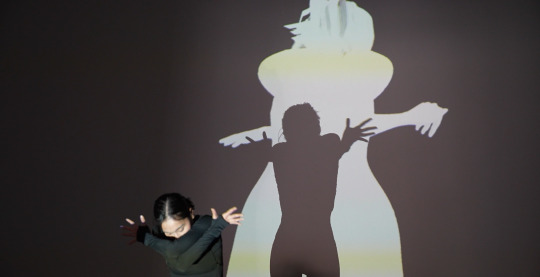
The 3D model projected on Kin/the wall behind her was impactful, even just as a white silhouette (or perhaps because of the simplicity of the silhouette).
The webcam flips the camera feed and thus the motion capture renders the digital figure's movement as opposite to Kin’s movement. This was a happy accident - Kin spoke to her feelings of being in conversation with the projection due to their mirrored positionings - they would face each other or away from each other, she would react to it and augment her movement in relationship with it, all the while driving its movement.
Further, her shadow disrupting the projection allowed for deeper interaction where, through her shadow, her form shared wall space with the projected form.
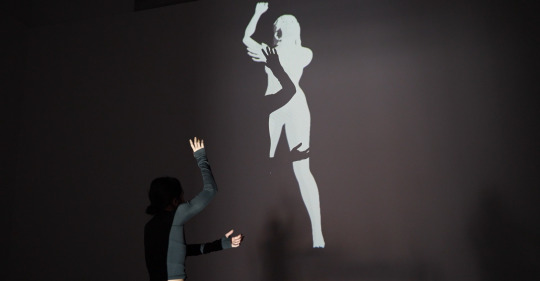
In response to the "activation" that happens when the mocap calibrates, Kin had the idea of almost "putting on" the body, by entering a stage with a still uncalibrated form and then the motion capture activating. I think this is a brilliant way of bringing the audience into the technical process behind what’s happening.
For the future:
Working with an unmirrored body, different body forms both human and non human, different forms of clothes and hair, simulating alongside the body, multiple bodies driven by one person, one body driven by multiple people, multiple bodies driven by multiple people, etc. The transitions between them could add interesting narrative to the work.
Some questions that come up here:
What possibilities exist with more than one body, both physical and digital? How do we feel when the body is a shadow vs. mirror image vs. totally different character? How does scale (human scale vs. huge vs. other possibilities) change the way the dancer and the digital twin relate to each other? How does the glitch of the body augment the audience experience of the relationship between physical and digital? How can we invisibilize it and highlight it at different time to push awareness of our conceptual exploration? Can to people dance apart together through overlapping projection?
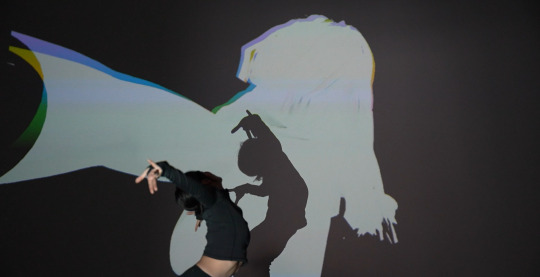
We also tried simple motion capture for FBX export with the Cyan tool. Unfortunately with the given model there was a multi root error importing to Unreal Engine. The better option would likely be to record movement directly in Unreal which I’ll figure out the workflow for before the next session.
TouchDesigner with Teachable Machine, OpenCV, MediaPipe (X), + StreamDiffusion
Our next experiment was with various TouchDesigner setups.
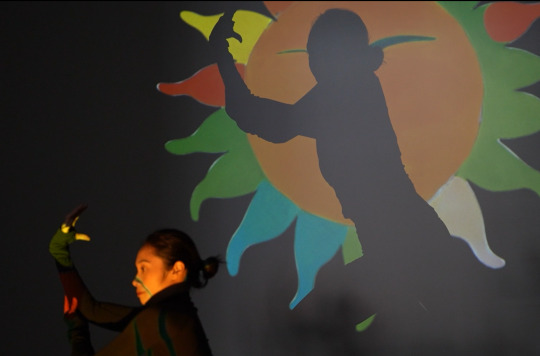

We began with Teachable Machine pose training. The idea was to train on two specific poses and have Kin move through movements into these poses with the images only appearing when the pose was hit.
Super interesting concept but less successful in execution. Because of the quality of the webcam and the darkness of the space needed for projection, the pose detection simply wasn’t accurate or detailed enough and was generalizing such that the images were always showing up.
For the future:
Using more balanced lighting, a higher quality webcam, and getting more insight on how to create a base condition with the tool would all help develop this in the future. Kin also spoke to bringing in choreography so we have a better sense of poses to hit and can test it further.
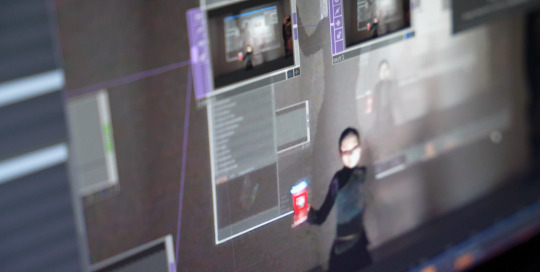
We then tried object detection with OpenCV with the intention of detecting objects in physical space and replicating them in digital space, without the dancer's body. This could be done using images or 3D objects that map their position and scale to their physical twin, manipulated by the dancer.
We learned high contrast color images would work best. In this case, the white maple leaf on the red Tim Horton’s cup was identified much better than the picture of the dark webcam on a white background, which was easily confused for small dark areas on light.
I also couldn’t get the digital image to follow the position correctly, only a rectangle worked.
For the future:
Consulting Evangeline on TouchDesigner or coding a tool with p5.js could help this exercise be more successful. Future possibilities include specific object detection combining Teachable Machine and OpenCv, following objects, and perhaps interaction between pose detection and object detection, not sure for what yet.
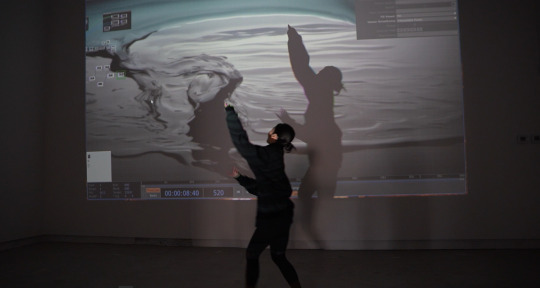
Our final experiment was with MediaPipe and Stream Diffusion in TouchDesigner. Our goal was to have body movement drive abstract landscapes/scenes. MediaPipe would not load so we didn’t have pose detection for Stream Diffusion. Instead we used webcam footage of Kin to drive the real time AI video. We tried water, fire, fluid, skyscrapers, painting, and clay. All quite interesting.
For the future:
Often a human figure our shadow would appear with high number of steps so a step value of about 18 - 23 was ideal. Not sure what type of imagery to focus on or how to incorporate this yet as there’s so many options. Possibly pose detection could drive changing scenery, similar to Teachable Machine but with animation vs. image? Also need to fix the perform tool with this.
Questions from this portion include:
What does it mean when the projected visual twin is NOT a digital twin/body but instead an abstract form or object? How do we infer relationships between dancer and objects? In puppetry when does it feel like a puppet and when do we forget about the puppeteer? Can we invite the audience in for either of these approaches and what impact does that have? How does it feel to have movement/poses trigger digital actions?
Future Areas of Exploration
There's a lot to experiment with including improvements on this research session and new areas of inquiry. This is what's on the docket:
More motion capture recording, this time with UI and MOVE via video (record dance on video simultaneously)
Film some dancing with additional dancer to create modern take on Pas De Deux + explore layered motion capture
Experiment with multiple people to one body, one person to multiple bodies, etc.
Bringing in choreography, developing for specific projection <> body interaction
Troubleshooting Teachable Machine, improving interaction with other sketches, MediaPipe, OpenCV, etc.
Interpretation of poses as specific visual meanings to drive both images and Stream Diffusion
Varied object detection
3D scanning dance poses
Try Rokoko motion capture suit
Seamless transition between tools
We'll also work on continuing to develop the narrative (even if that's just an ordering of tools) and continue to have conversations about what this brings up as a dancer and as a technologist!
And that's all for now folks :)

#motion capture#art#new media#animation#dance#projection#practice based research#interaccess#toronto
0 notes
Video
tumblr
Avin Software Apr 1997 Archived Web Page
0 notes
Text
Winter 2024! (newsletter)
(a copypasta from the newsletter, saved here for ease)
Happy 2024 ! :) ✩
Here’s a round-up of everything I’m working on in the upcoming Winter season ❄️
2023 Highlights →
Octavia Butler AI with Dr. Beth Coleman
This was my second (and a half) year working with Beth on her AI project inspired by Octavia Butler’s writing. With a bespoke AI Image GAN, we created images series inspired by Alice Coltrane, oceanic jellyfish, and Black Panther Party gatherings. Images were reproduced as oil paintings, and documented through a web archive, an exhibition and symposium, and (most excitingly) a published book.
UNCG
I returned to the College of Visual and Performing Arts at University of North Carolina Greensboro as an instructor of two classes, Intro to Web Design & Professional Practices. The latter focused on portfolio & CV building to support students as they graduate into careers as working artists.
Artivive AR Residency
In April, I wrapped up a year-long mentorship residency with Artivive, an AR platform focused on artists. My first time using Blender, I worked with my mentor Agnes Michalczyk, and produced an AR sculpture PaperCuts that has since exhibited in Vienna at Artivive headquarters and in the Geary Art Crawl 2023.
InterAccess
First complete year with InterAccess as Programming Manager (and first day job!) Very grateful for the opportunity to work full-time in a permanent arts position. Highlights include starting an Open HDMI event series, an after hours event inviting visual artists to plug into InterAccess’s in-house immersive projection system, IA 360°, in an open deck style. Several Open HDMI events of the same name have been popping up around the new media scene since the first IA event in April! (1) (2)
Upcoming →
Did You Eat? | Group Exhibition @ Ed Video | January 15 – February 15, 2024
I’ll be showing a series of remixed recipes on acrylic, Ju/uu/ook,as part of a symposium focused on ✩FOOD✩ (including food production vs insecurity, cultural dishes’ role in nostalgia and tradition, and consumerism vs consumption)
Ju/uu/ook looks at the shifts in traditional recipes - whether through generations, miscommunication, or flirtation with shared or adjacent cultures - as something to be welcomed, rather than lamented as culture lost.
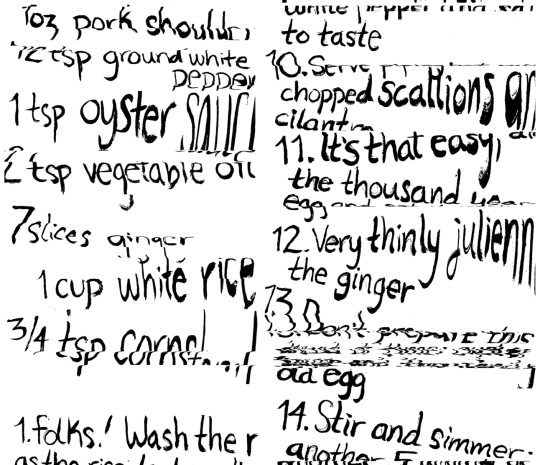
section of the distorted scan
Recipes for juuk, char siu, and joong were run through a custom Python script, randomizing the ingredient measurements and instruction order to create a copy, reminiscent of the dish, but nonsensical. The new recipe was then written by hand with traditional calligraphy tools, digitally scanned with physical distortion, cut into acrylic, and then handpainted once again.
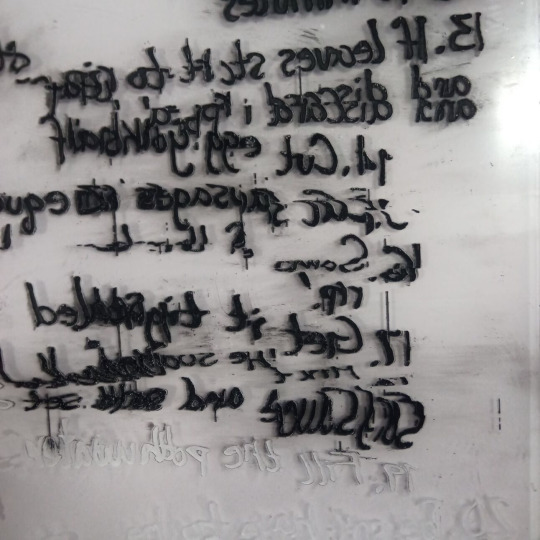
painting process! the text was cut in reverse on the back so it appears to float from the front
This project started over a year ago through a School for Poetic Computation course, Digital Love Languages, where I developed the Python script that remixes the recipe text.

snapshot of the code
Did You Eat? | Closing Reception @ Ed Video | Feb 9 2024, time TBA
Closing event to celebrate the exhibition – including a potluck!
Did You Eat? | Artist Panel @ Online | Feb 10 2024, 3PM
Online panel discussion with the other exhibiting artists; email [email protected] to register.
Topics in Communication, Culture, Information & Technology | Design Consultant @ UTM | Winter semester
I’ll be working with Dr. Beth Coleman supporting her class researching conceptual data visualization with a fabrication focus.
Solidarity Infrastructures| School for Poetic Computation
I’ve been accepted to a course (on scholarship, big thank you to equity pricing) with SFPC, starting next week! We’ll be learning about “slow web, organic Internet, right-to-repair, data sovereignty, minimal computing and anti-computing”. Very excited!
Day job updates / InterAccess →
Media Arts Prize Programming | InterAccess | Jan 17 – Feb 17, 2024
↪ Exhibition: once more, once again | Ghislan Sutherland-Timm | January 17 – February 17, 2024 ↪ Exhibition: Kaboos: An exhibition of nightmares | Mehrnaz Abdoos | January 17 – February 17, 2024 ↪ Workshop: DIY Vacuum Formed Lamps | Audrey Ammann January 30, 2024, 6 – 9PM ↪ Artist Talk: Farming the Future | Murley Herrle-Fanning | February 3, 2024, 2 – 3:30PM
0 notes
Photo
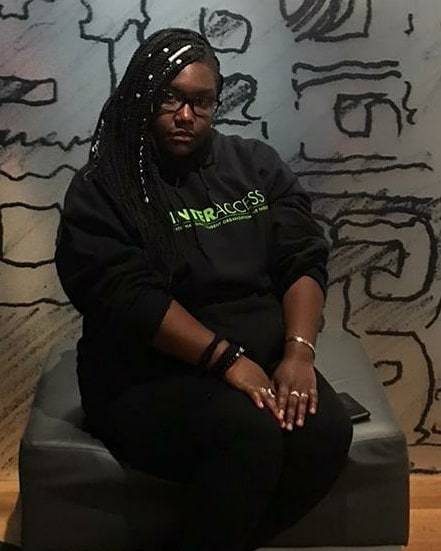
👑 Keeping my head high so that my crown doesn't fall! 👑 📸 : @verenaxcharry Taking my rightful place in the chocolate museum. #BlessedWithTheBest #MelaninPopping #BlackGirlMagic #RaisedInPower #PositiveVibes #Perfection #BlackGirlAutumn #ChocolateInTheMuseum #Colonge #Germany #CathedralQueens #MoodCheck #Clownerij #BossLadies #Köln #InterAccess #WeekendTrip #ChocolateMuseum #QueenOfChocolate #MillyoshcaBute #TeamAlpha #AlphaMentality #Myjourney #TiempoDeMillyoscha #VeniVidiVici #IDidntComeToBow #ICameToConquer #QueenOfMyOwnDestiny (at Schokoladenmuseum) https://www.instagram.com/p/B5fmndPAob7/?igshid=1nycqy6yjbuf6
#blessedwiththebest#melaninpopping#blackgirlmagic#raisedinpower#positivevibes#perfection#blackgirlautumn#chocolateinthemuseum#colonge#germany#cathedralqueens#moodcheck#clownerij#bossladies#köln#interaccess#weekendtrip#chocolatemuseum#queenofchocolate#millyoshcabute#teamalpha#alphamentality#myjourney#tiempodemillyoscha#venividivici#ididntcometobow#icametoconquer#queenofmyowndestiny
0 notes
Video
youtube
#The Princess Bride#Rob Reiner#Andrew Scheinman#William Goldman#Cary Elwes#Mandy Patinkin#Chris Sarandon#Christopher Guest#Wallace Shawn#André the Giant#Robin Wright#Peter Falk#Fred Savage#Billy Crystal#Mark Knopfler#Adrian Biddle#Robert Leighton#Act III Communications#20th Century Fox#Interaccess Film Distribution
1 note
·
View note
Photo

My first 3D print! Thanks @interaccessto for two weeks of great courses! #3dprinting #cats #miniature (at InterAccess) https://www.instagram.com/p/B9KwjS4AAlo/?igshid=yawvuopztnsn
4 notes
·
View notes
Text
February & March workshops at co:Lab & InterAccess
February & March workshops at co:Lab & InterAccess
Bio-Data Touchpads @I/A
Tuesday, March 3rd 6PM-10PM $95 for members of I/A $125 for non-members, includes materials fee.
Tosca Teran will lead a workshop on how to build customized touchpads that can trigger sounds, samples, and sequencers, collect bio-data, be used with analog or digital synthesizers, and so much more. With this device, you can start listening to your BioData!
Create…
View On WordPress
0 notes
Video
instagram
Tuesday I was the very proud and extremely grateful recipient of the InterAccess Mentorship Contest Award. This award includes a one year membership to InterAccess and it’s fantastic workshops, I am so excited to fully utilize this membership to continue learning and expanding my artistic practices post graduation. Thank you to @interaccessto , as well as to all the faculty & staff in @ryersonfcad and @RTARyerson . I would especially like to thank the amazing faculty and staff in @ryersonnewmedia who make this fantastic program possible. I found my home in New Media and I found my ambitions, goals and dreams in the opportunities provided to me by this program and those behind it. Thank you. #ThankYou #Ryerson #NewMedia #RTA #FCAD #InterAccess #RU (at Toronto, Ontario)
0 notes
Video
youtube
Most recent video edit for my thesis project Habitual Instinct. Since graduation it has been exhibited as a part of Vector Festival 2017 which was hosted at InterAccess in Toronto.
0 notes
Text
Journal Entry #2

I would like to take this opportunity to discuss the importance of workshops for members of the artistic community.
One of my favourite things about working for InterAccess is being a part of an organisation that’s dedicated to facilitating a wide range of on-site workshops. Our educational coordinator works tirelessly in order to produce year-round programming that focuses on a wide variety of artistic skills: machining, electronics, communication technologies, 3D printing etc.
Different workshops tend to attract different artists, and a general assumption may be that artists come in, learn a skill, leave, and apply it to their own art. This assessment is technically true but doesn’t take into consideration the broader social benefits of facilitating and developing artistic communities.
By accommodating a constant schedule of workshops in a comfortable environment (InterAccess’s workshop), InterAccess has managed to develop a community of like-minded artists who regularly meet to develop and exchange information and ideas. These workshops have turned into a much more important long-term community development program that accommodates the technical and creative needs of participants; the facilitation of such a community creates a free flowing network of ideas that inevitably leads to collaboration, group exhibitions, and creative partnerships.
It’s important to recognise workshops as more than just an opportunity for artists (or students) to learn new skills under the guidance of an instructor. By following up with participants, inviting them back for opportunities to socialise, encouraging them to stay connected, and encouraging the exchanging of ideas/information, workshops can act as initiation points for broader long-term educational opportunities.
0 notes
Text
Tara Is A Real Artist, You Can Tell By All The Practice-Based Research Going On

In September of 2024, I had fifteen conversations in the span of one week about the future of my practice and working life.
At that point, I had three pillars I wanted to develop for my career, four projects I wanted to work on, and a whole lot of uncertainty over how to prioritize achieving any of these things. I included the above representative images in the document I shared during those conversations.
Art IS imagining and realizing your imagination into reality, but I felt enveloped by the intangible, unrealizable, infinite of possibility. As I was talking, everything I was imagining in my head tripped over my words into a mess of confusion and uncertainty. I enjoyed hearing from the folks I was talking to but I felt I wasn't holding up my end of the bargain as a conversation partner with any self confidence.
Some of the questions that screamed into mind during these conversations were:
Is any of this good or interesting art?
Are you believing that it is when I don't even believe it myself?
How can I help you understand the full extent of what I care about/am doing?
Or am I simply too unfocused to articulate any essential information without a hundred tangents?
It was truly an exercise in tolerating severe anxiety and maintaining outward composure.

Now, I have three projects in various stages of development. I am pursuing teaching as the foundation for my career. And I am contracted for two ongoing motion design projects. Why am I not spiraling in the black hole of uncertainty?
First, I chalked the crisis of self confidence up to skill issue and began developing the skills I was missing. I came up with new questions to answer:
How could use I research to ground my work and truly feel like I was learning something meaningful through my process?
How could I put my work out into the world more to get consistent and direct feedback rather than depending on any one conversation?
How could I reach out to folks who know more than me to learn from and collaborate with?
Practice, here meaning repetition, is the best teacher. And I've been blessed with opportunities to practice since September.
I’ve spent the better part of the year as a member of NEW INC’s Art + Code cohort (the genesis for those fifteen conversations in the first place), developing a project MOVES and the scaffolding around it with the support of my peers and mentors.

This has included exploring readings to try and understand what drew me to this project in the first place and the broader contemporary discourse around digital embodiment. It also included sharing and receiving feedback on my technical and conceptual explorations quite often.
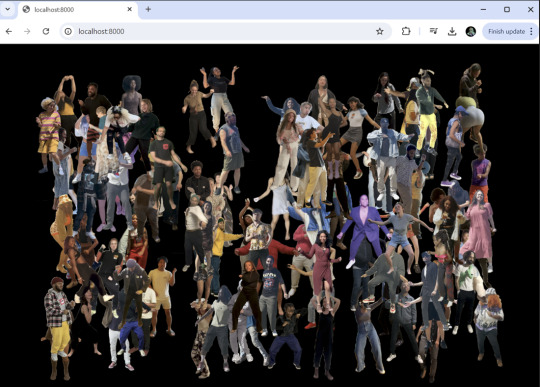
I’ve also been a member artist of InterAccess, where instead of simply creating work and releasing it into digital space, I’ve been able to show work at scale in a gallery environment and receive direct feedback from audiences and peers alike.
Both these experiences have supplemented my lack of formal arts education / skill issue through experience and external accountability, wherein I now feel (more) equipped to take a project from development to distribution.
Through these experiences and my own explorations/reflections, I’ve also developed a clearer thesis for where I’m trying to go with my work.
I know the pillars of my curiosity are embodiment and belonging, both separately and in relation to each other, as mediated by technology, successfully or not. Everything I do ties into these curiosities and allows me to dig deeper/push further into some as yet unarticulated philosophy/manifesto. It makes everything I do part of a narrative, and it’s much easier to express cohesively. Which isn’t to say the process isn’t messy - part of my learnings have been that the art can be a question rather than an answer. And that the practice is the point! It’s all research!
This line of inquiry has directly led me to the two other projects I'm taking on:

The first, The Handprint and the Hand, is applying coding skills and conceptual research I began developing with MOVES into further practice-based research with an exceptional dancer in Toronto (Kin - see my last post). I am extending the idea of digital embodiment to focus on using computer vision as a reflection on the erasure of human effort in information technologies.
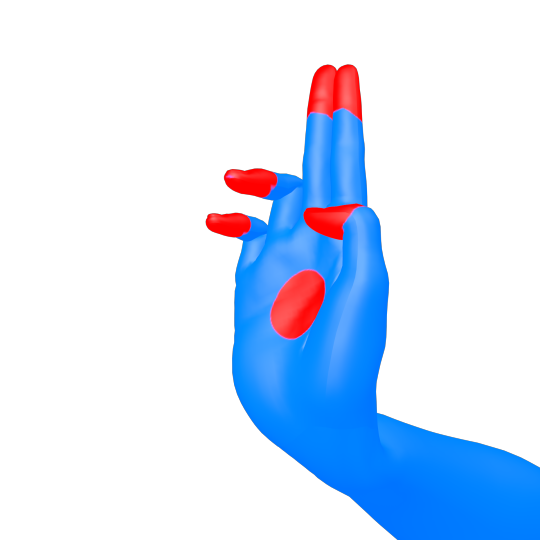
The second, MUDRA.js will continue this research with a focus on the narrative interpretation of the gestures performed in Bharatanatyam, using computer vision techniques I'm playing with during Handprint but bringing in a new dimension of the successes and failures of technology in developing and preserving cultural understanding.
While still in early stages - a preview of Handprint will be staged in June and MUDRA.js won't begin until the fall - I can clearly see the threads of continuity as I apply for grants, residencies, and in kind support for the work. And MOVES is showing at Nuit Blanche 2025 with supported events leading up to it beginning with Doors Open Toronto at the end of May. How exciting!

I'm still having lots of conversations and the work is still in progress. But I have some answers to my questions:
Is any of this good or interesting art? If I am learning things through my art making process that is good and interesting enough.
Are you believing that it is good and interesting when I don't even believe it myself? I am genuinely excited to share the things I am learning with you.
How can I help you understand the full extent of what I care about/am doing? I have a clear narrative of what I care about, what I'm doing, and how they connect.
Or am I simply too unfocused to articulate any essential information without a hundred tangents? I have a plan with both personally and externally accountable parts that I am focused on completing. The essential information is all connected and thus easy to parse and articulate in different contexts.
And now the conversations I'm having feel like they bring clarity rather than confusion! And all it took was eight months of intentional research, practice, talking, and thinking.
#animation#art#blog#taramoves#handprintandthehand#moves#artists on tumblr#practice based research#practice#research#digital embodiment#mudra
0 notes
Photo

HAVN presents a night of sonic exercise and extraordinary feats of sound making with performances by Sophia Oppel & Doobie Freaks. Sets: ‘Measured Participation’ by Sophia Oppel @ 7:30pm 'For Your Convenience’ by Doobie Freaks @ 8:15pm PWYC by donation ~ Limited seating. Measured Participation BY Sophia Oppel “As we exist in digital environments we generate data to be mined by corporations; to have a digital presence is to perform unpaid, immaterial labor. This flattening of work and leisure means we are in a constant state of training; we are being directed by our online activities to carry out affective work. Measured participation makes reference to bio-tracking and fitness applications that facilitate data production and self-administered disciplinary regimes. I wanted to draw a parallel between training one’s body and being trained as a producer of data commodities online. This installation involves one performer in a blue one-piece suit who executes an exercise routine on a blue yoga mat as a video and voice-over play. The sound piece takes the form of an auto-tuned voice-over that reflects on the lived experience of provided unpaid virtual labour. The video presents a variety of found footage depicting exercise gurus performing workout regiments alongside stock-footage of people using digital devices. While the performer exercises, they are live 3D scanned using an Xbox Kinect. The live feed is projected into the existing video work.” Sophia Oppel is an arts practitioner born and based in Toronto, Ontario. Oppel’s work addresses the position of insidious, hegemonic power embedded in networked existence and its manifestations in embodied experience. Oppel’s practice is based in digital media and interactive installations; employing algorithms, web applications and software pre-sets as subject matter, she attempts to deconstruct the implicit assumptions imposed upon users. Oppel received her BFA from OCAD University and is currently a co-director of Bunker 2 Gallery and a Curatorial Project Assistant at Gallery 44. Oppel has exhibited locally and internationally, including shows at InterAccess Gallery, Queen Specific, Gallery TPW, Bunker 2, Forest City Gallery, Xpace Cultural Center and Supermarket Art Fair, Stockholm. __________________________ “For Your Convenience” BY Doobie Freaks Doobie Freaks is a legendary un-music band from Hamilton, Ontario. They will be performing within the confines of a vending machine where they will be making music, recording music and releasing it through the vending machine’s dispensing door for change. Is this about space (both physical and time) and convenience? Is it about inconvenient music in an inconvenient space? Or the inconvenience or convenience. Is it about FOMO or YOLO or LOL? Or is this just the doobie freaks being doobie freaks?
#sas#sonicartseries#sonicart#soundart#havn#havnode#hamiltonaudiovisualnode#hamont#art#oac#mediaart#hamilton
1 note
·
View note
Photo
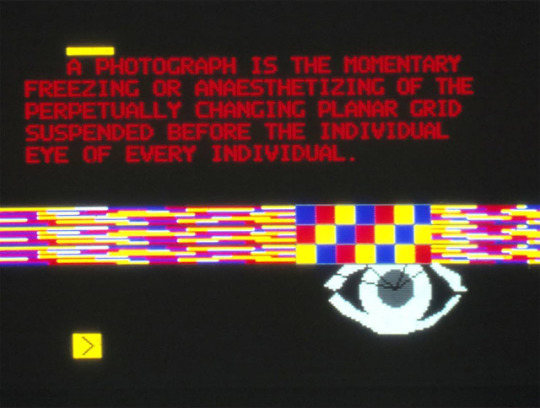
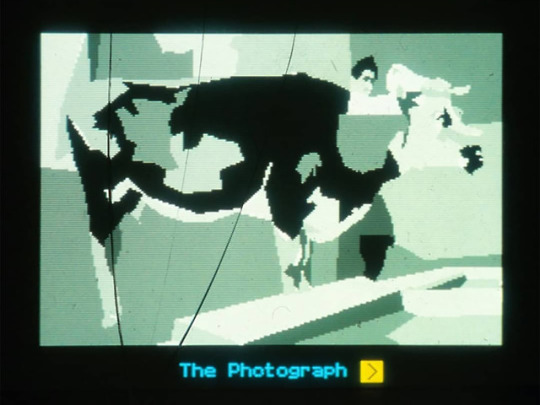

3 slides from Douglas Porter’s “ The Style: Modern Life As A System of Subsystems“ { According to InterAccess, The Style was ”Originally an interactive videotex database, an electronic magazine containing ‘pages’ of video, graphic and text based content for Telidon users to view.” The Telidon was an experimental videotex/teletex platform developed by Canadian researchers in the late 70s and early 80s. InterAccess has been sharing work created for the Telidon by Canadian new media pioneers, check out their ig.
Forreals tho, this is the best definition of photography that I’ve seen.
#telidon#new media#postphotography#photography#net art#preglitch#glitch art#glitch photography#postdigital#videotex#teletext#digital art#contemporary art#art history#glitch history
137 notes
·
View notes
Photo

Melanin absorbs sun light. We are light filled. We lit! #BlessedWithTheBest #MelaninPopping #BlackGirlMagic #RaisedInPower #PositiveVibes #Perfection #BlackGirlAutumn #FunInTheSun #Blessings #BlackExcellence #Köln #InterAccess #WeekendTrip #Colonge #Germany #CathedralQueens #MoodCheck #Clownerij #BossLadies (at Köln, Germany) https://www.instagram.com/p/B5YftZhAYYl/?igshid=1enm63o9xewo6
#blessedwiththebest#melaninpopping#blackgirlmagic#raisedinpower#positivevibes#perfection#blackgirlautumn#funinthesun#blessings#blackexcellence#köln#interaccess#weekendtrip#colonge#germany#cathedralqueens#moodcheck#clownerij#bossladies
0 notes
Text
Zoomer In (21 Jan 11:15-13:15 GMT)
Xuan Ye 叶轩
(they/them, Beijing Normal University-Hong Kong Baptist University United International College (UIC))
As an educator, I consider pedagogy as a form of publishing and praxis of resistance. In the course Publication Design, I see common threads in my students’ publication projects where they give insightful critique of social issues in China such as the arising feminism and the digital mediascape. In the context of mainland China where being silenced is the ineffable norm, self-publishing has become a viable outlet of activism and critical thinking for the zoomers. This collective presentation attempts to zoom in these aspects as a specimen of the larger zine cultures in China. In this session, four BNU-HKBU UIC students will present their publications: Bin Yu (*She Production*), Qianyue Chen (*Parse of LOVE*), Nuo Chen (*The Digital Grave*) and Jialiang Ji (*Perfect Fund Guide*).
Xuan Ye (they/them) is a practitioner in music, design, web, art, and education, currently working between the Pearl River Delta and Tkarón:to/Toronto. Ye’s body of work translates between various modes of being and creation, synthesizing language, code, sound, body, image, data, light, and time. Ye’s work has been featured, exhibited, and performed internationally, including at peer to space (GE), Centre de Design de l’UQAM à Montréal (CA), Varley Art Gallery (CA), Canadian Art, the AGO (CA), Vivid Projects (UK), InterAccess (CA), Inside-out Art Museum (CN), Goethe-Institut (CN & CA), ArtAsiaPacific, KUNSTFORUM (GE), among others. Ye was a finalist of EQ Bank Digital Artists Award in 2018 and a recipient of a SSHRC scholarship. Ye’s music performances and releases have received critical accolades from Bandcamp, Musicworks, and Exclaim!. Ye was appointed Assistant Professor at BNU-HKBU in 2021.
https://a.pureapparat.us/ Instagram: @apureapparatus Contact: [email protected] for personal inquiries [email protected] for academic inquiries
#pedagogy as publishing#zines as mediums of resistance#self-publishing as forms of feminist practice and world making#day two
0 notes
Text
mapping thinking with moving weirdly
I would like to notice how the city affects my response system by mapping my physical compositions to public sites. I work with a performance practice I call “moving weirdly.” moving weirdly involves an action of feeling into the moment of being witnessed and allowing surprising physical responses to surface. Moving weirdly involves a conscious choice to let my trauma-informed responsiveness be present in the moment in a non-harming expressive way. I let myself be distracted from a preconceived aesthetic of presence. Component actions involve listening, accepting, responding, following and not imposing on myself a need to encode those physical responses into language. As an art practice, I believe that the meaning of the text is generated in the interstice between utterance and my physicality. As a map, the meaning might accrue from finding patterns in relation to where I can go to tune into various spatial resources.
(This was written in response to Interaccess workshop Mapping As Mutual Aid with Lucas LaRochelle who leads a collaborative workshop and lab on the GIS and counter-mapping strategies used in their Queering the Map project.)
0 notes